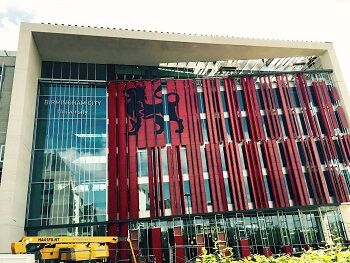University News Last updated 09 June 2016

Birmingham School of Architecture and Design lecturer Jim Sloan has recently placed emphasis on the “valuable experiences” gained by students through maintaining longstanding industry connections with construction experts Willmott Dixon.
The firm is currently building the third phase of Birmingham City University’s City Centre Campus, Plot 2A (behind The Curzon Building), bringing extra teaching space to the campus.
The partnership
The partnership began around five years ago when the organisation won contracts for both The Parkside Building and later The Curzon Building, with an “important” element to the agreement being the development of student engagement within the School. Jim Sloan, Lecturer at Birmingham School of Architecture and Design said:
Site visits
One of the main focuses of the partnership is on students obtaining knowledge about design specifically through site visits, as well as uncovering key site processes and learning first-hand how to actually build a building.
This includes understanding the basics of the process and the “endless” considerations and informed choices such as materials, textures, and practicalities of construction and maintenance that are all involved within a strategic and well-planned build.
Practical workshops
Practical hands-on workshops have also been possible since the partnership with Wilmott Dixon, covering specialist techniques such as brick laying, which incorporated another partner of the School, Ibstock, to provide the bricks, with a group made up of around 20 first and second year students taking part at the end of each academic year. Jim added:
“This has really helped our students understand materials from a different perspective. Often architects are criticised for not being practically-minded, and not understanding the specifics of a build.”
One-to-one “mock-ups” making an actual part of the building, usually a key junction (an area that is fundamental to the success of the building), help reveal finishes and how potentially unconstructed elements of the building will look before they are actually completed on site. Jim added:
“Once phase 2A is completed we will effectively be back to two dimensional information again, through producing real sections of the building the information is retained within the School, leaving a lasting legacy for the project and a permanent useful resource. This brings things to life one-to-one. You might have drawings, digital models and photographs, but having fragments that are real parts of the building is really valuable.
“This stretches the skill and understanding of the students. It also provides the academics with an opportunity to see how students respond to using these real resources as opposed to two dimensional drawings, encouraging research into how students learn.”
To keep up to date with all of the latest news and information from Birmingham School of Architecture and Design, follow @BCU_BSoAD on Twitter and Instagram.